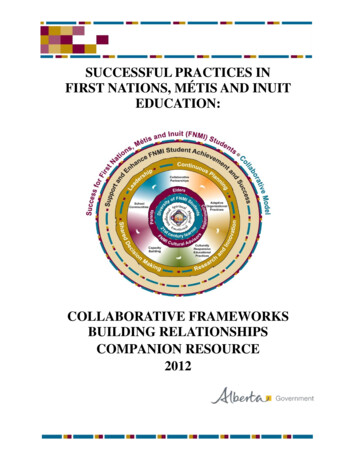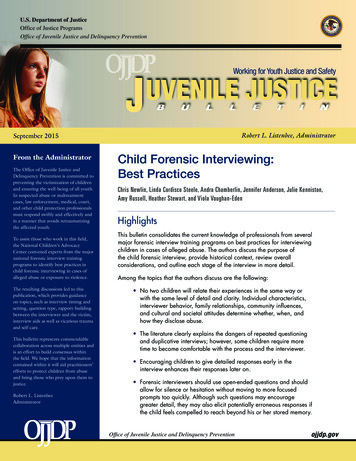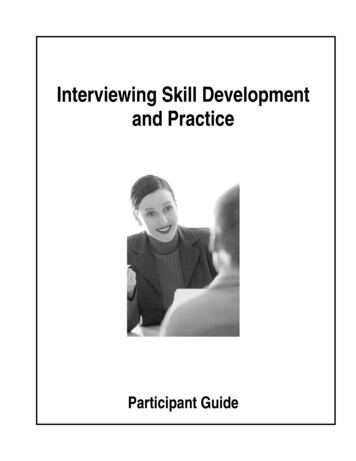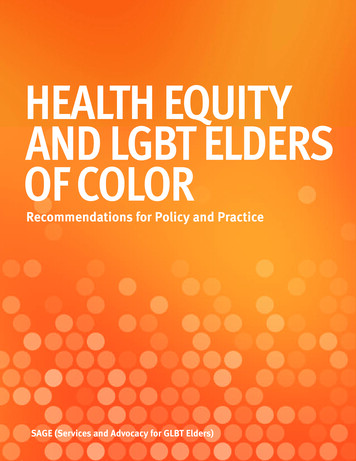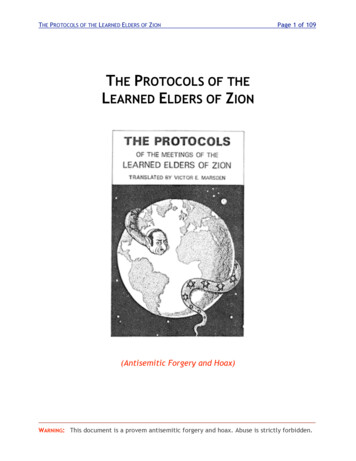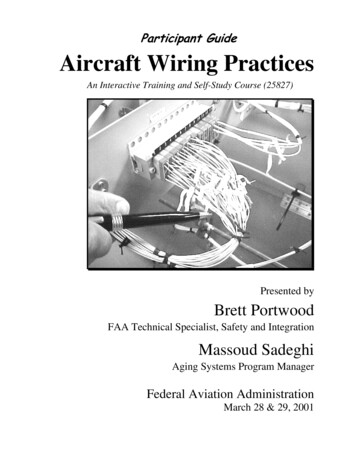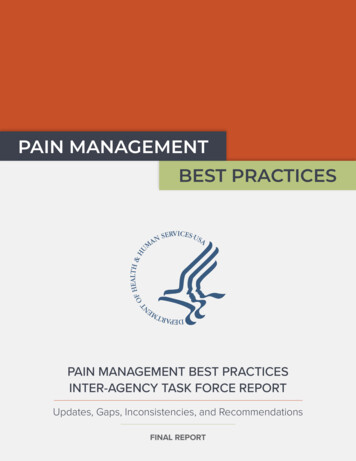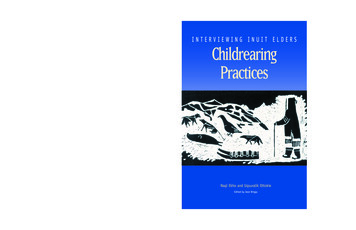
Transcription
9:05 AMPage 1INTERVIEWING INUIT ELDERSChildrearing Practices5/1/06ChildrearingPracticesINTERVIEWING INUIT ELDERSCovers -- E3Naqi Ekho and Uqsuralik OttokieEdited by Jean Briggs
6507.5 Fre5/1/069:11 AMPage 239
6507.4 Eng5/1/069:03 AMPage 1INTERVIEWING INUIT ELDERSVolume 3ChildrearingPracticesNaqi Ekho and Uqsuralik OttokieEdited by Jean Briggs
6507.4 Eng5/1/069:03 AMPage 2Interviewing Inuit EldersVolume 3Childrearing PracticesCopyright 2000: Nunavut Arctic College and Naqi Ekho, Uqsuralik Ottokie, Jean Briggs, AlexinaKublu and participating students (as listed within).Cover illustration “Man and Animals” by Lydia JaypoodyDesign and production by Nortext (Iqaluit)All rights reserved. The use of any part of this publication, reproduced, transmitted in any form or byany means, electronic, mechanical, photocopying, recording, or otherwise, or stored in a retrievalsystem, without written consent of the publisher is an infringement of the copyright law.ISBN 1-896-204-376Published by the Language and Culture Program of Nunavut Arctic College, Iqaluit, Nunavut withthe generous support of the Pairijait Tigummivik Elders Society.For order information:Nunavut Arctic College LibraryBox 600Iqaluit, Nunavut X0A 0H0
6507.4 Eng5/1/069:03 AMPage iTable of ContentsACKNOWLEDGEMENTSMAPINTRODUCTIONChapter 1Chapter 2Chapter 3Chapter 4Chapter 5Chapter 6Chapter 7Chapter 8Chapter 9iiiiv1Life StoriesNaqi EkhoUqsuralik Ottokie2125PregnancyThe mother; the foetus; rules to facilitate birthing; memories of foetal life.31Birthing PracticesPositions; sanaji: responsibilities at birth and after birth; sipiniq; naming;treatment of the newborn.37UpbringingDiscipline/behaviour problems; showing a child it is loved;encouraging it to thrive; teaching skills; teaching respect forothers and elders; teaching how to care for others; babies, helplesspeople, good behaviour and responsibilities. How to strengthen achild's mind; how not to spoil children; effects of defending; how tostop giving in to children and doing everything for them.51ChildhoodCross-sex socialization related to name; gender roles; sibling relations.73Nutrition and HealthChildren's food rules; treatment of illness.81Special CasesAdopted children; orphans; mistreated children; disabled children.91Children’s EmotionsIlirasuktuq, ninngattuq, kipiliqtuq, kanngusuktuq, sillujuq; respectingchildren's individuality.101Stories, Games and Songs107GLOSSARY129REFERENCES137
6507.4 Eng5/1/069:03 AMPage ii
5/1/069:03 AMPage iiiA C K N O W L E D G M E N T SWith much heartfelt gratitude we would like to thankthe Pairijait Tigummivik Society for funding thepublication costs for this series.Nick NewberyWithout their contribution this series may not have become a reality.Nick Newbery6507.4 Engd/oic7mE4Lt4 scsy3u[l wo6fy3u[lwo8ix3ioEJ5 kNK5 yM5g6n3F1u d/8N DmK5 XwE/w5tA7uF4f8i4 Ns/6bc6t5tJ8N3mbsfx n6rtbsJ8N3i4nzk5. giy8i Q2Xb sfx Wbco Qgw8NExcC/Ms6S5.
547148109111315121721192220232425269:03 AM3616185/1/06216507.4 EngPage ivMapv
yde RiverCoral HarbourHall BeachIgloolikRepulse BayPelly BayArctic BayX8i6 6er6b3Jx6 QikiqtarjuaqCape Dorsetwclw5r Zw5vq6gÛW4n9o6niC/4w[lo4Ns 242322212019d3l6g6ezs4su1m4 6NanisivikMittimatalikGjoa HavenTaloyoakBaker LakeArviatWhale CoveRankin InletKugluktukBathurst InletBay niqChesterfield Inlet IgluligaarjukNanisivikPond Inletwcl4 4tx6 Cambridge Bays6h6 bo49:03 ikiluaqSanikiluaqnirlx616507.4 EngPage v
6507.4 Eng5/1/069:03 AMPage vi
6507.4 Eng5/1/069:03 AMPage 1IntroductionInuit Childrearing Practices:an IntroductionAs soon as you show the child pure,unconditional love, without everraising your voice to them, withoutbeing physically abusive, they growbeautifully. If we truly love ourchildren we will not defend them. Inour hearts we defend them but we donot show it. (Uqsuralik)Each society lives on through its children. Children have to become responsibleadults, who can take care of themselves as well as their relatives. In this bookInuit childrearing practices are described by two elders from South BaffinIsland, Naqi Ekho and Uqsuralik Ottokie, who showed great wisdom in theirrecollections of the past. Childrearing practices are rapidly changing in the moderncommunities of Nunavut. Day care, nursery schools and primary schools havebecome part and parcel of everyday life. Yet many features of traditionalchildrearing can still be observed. Most young Inuit women still carry their babiesin the amauti, providing them with an emotional and physical comfort no strollercan provide. Many of the students who conducted the interviews were parentsthemselves trying to come to terms with values of Inuit childrearing and therequirements of modern society.Uqsuralik playing inugannguat.Introduction – Inuit Childrearing Practices1
6507.4 Eng5/1/069:03 AMPage 2The interviews were conducted by Susan Enuaraq, Myna Ishulutaq, Nancy Kisa,Bernice Kootoo, Aaju Peter, Jeannie Shaimaiyuk, and Julia Saimaiyuq, second-yearstudents in the Language and Culture Program; and first-year students, Vera Arnatsiaq,Matthew Boki, Kim Kangok and Johnny Kopak. They had just completed a course ontraditional law and the second-year students in particular had quite a lot of experiencein interviewing elders.The course was faciltated by Jean Briggs, Professor Emerita at Memorial Universityof Newfoundland. She has studied Inuit emotional concepts, social values and play, andchildrearing practices for more than a quarter-century. In her numerous publications shehas shown a great appreciation for the subtlety and skill of Inuit childrearing practices.1No scholar would have been better suited to facilitate the course.The interviews cover a wide range of subjects. The book deals with pregnancy,birthing, early childhood, children’s emotions, child abuse, play, songs and stories, andmany other subjects relating to bringing up children. As Naqi observed: “Inuit have alot of knowledge about childrearing.” In this introduction I will discuss only a fewtopics mentioned in the book and focus on the elders’ perspectives. Their words expressInuit ideas and values most adequately. The elders were not just recollecting the past;they were relating the past to the present. They were emphasising those values of thepast that they thought most important to the present generation. Uqsuralik stated:When I am telling you these stories about how life used to be, I am notsaying that we were better than you are today. I am not saying ourway of life was better than yours. In a lot of ways it was not as good.But I certainly can say we were taught to lead a very good culturallystrong life. This is the kind of thing that I don’t mind talking about topeople concerned with social issues, or to people at justicecommittees. Some people come before us and instead of judging themI like to remind them that if they grew up like we did they would notbe in trouble with the law. They would have good morals, good valuesand beliefs. Of course you say these things because you want to helpthem. You want to help other people live a good life. Sometimes youthink that because they did not have these values and beliefs, they arein trouble. I was very happy when I was asked to come down here andtalk to you. I am not saying my life was much better than yours, but Icertainly want to pass on the importance of having strong familyrelationships and respecting rules.The upbringing of children was not just the responsibility of the mother. The wholecommunity was involved in it. The grandparents were very important as pointed out byUqsuralik:2Childrearing Practices
6507.4 Eng5/1/069:03 AMPage 3In the old days we used to spend a lot of time with our grandparents.They used to take care of grandchildren a lot in the old days. I usedto spend a lot of time with my grandparents and I was very close tothem. I always used to sleep with my grandmother. In the old dayswe grew up always sleeping with someone else. Today we don’t evensleep with our children, but in the old days we always slept with anadult. Because of that, you developed a very strong bond. When youhad cold feet they would always help you warm your feet up.Grandparents were very, very helpful.Children were taught by practice and they learnt from the elders:It was a happy time, even though it was very difficult, hard work. Butall in all, we were learning how to do things. We were never formallytaught how to do things. Today we are taught knitting or sewing bybeing grouped together. People were teachers only when they wereelders. (Uqsuralik)Naqi showing Uqsuralik a string game.The formation of a childWhen a woman was pregnant everybody was aware of it. Everything she did mightaffect the child. Even though Naqi and Uqsuralik did not have to observe the pittailiniq,the taboos, they still had to observe many rules. Naqi related:Pregnant ladies should always be swift. While walking you shouldnot be slow. You should always try to be the first one out of the house.That was one of the customs we had to follow. Before we didanything we had to go out of the house quickly, otherwise when wedelivered it would be a long process. Before we ate anything, weIntroduction – Inuit Childrearing Practices3
6507.4 Eng5/1/069:03 AMPage 4would go out. We would try to be the first one out. We had all sortsof rules we had to respect. If a pregnant woman went to visit, she wasnot supposed to just poke her head in. If she did that, the baby’s headwould take a long time to come out. A pregnant woman was not toprocrastinate. You never left any chore for later. You had to do itimmediately because it would help you out during delivery.Ritual observances also pertained to clothing.When you have kamiik that have laces you don’t tie them up. Youalways leave them undone, so the umbilical cord won’t wrap aroundthe neck. They always ask you not to tie the laces on your kamiik.During pregnancy, you don’t deal with strings that require wrappingor tying. You don’t deal with them so the baby’s umbilical cord doesnot wrap around the neck. Sometimes a baby comes out blue becausethe umbilical cord has been around the neck. I experienced that onetime where the baby had the umbilical cord around the neck. Thebaby couldn’t come out because the umbilical cord was wrappedaround it . For a pregnant woman, the rules were different thantoday’s rules. (Uqsuralik)Not fastening the strings of the kamiik is clearly an old custom. A tradition collected byFranz Boas (1904: 483) in the Cumberland Sound area relates:Akkolookjo and his wife Omerneeto established the laws which theEskimo have to obey now. Omerneeto used to wear her husband’sboots. She did not fasten the upper strings properly, but allowed theboot-leg to sag down and the boot-strings to drag over the ground.One day the soul of an infant that was on the ground crept up theboot-string and up into her womb. Up to that time, children had beenfound in the snow. The child grew in the womb, and finally was born.It began to cry, and gradually became old enough to speak. One dayit told its parents how it had crawled into Omerneeto’s womb. Itcontinued, “There I was as in a small house. Every night when youcohabited, a dog would come in and vomit food for me to make megrow. Finally I longed to get outside; and when I got out, I wanted tospeak, but all I could do was to cry. When I wanted other food thanmilk, I could only say ‘papa;’ and when I wanted to say ‘I am thirsty,’I could only say ‘oo, oo.’Thus the first child was born. A pregnant woman’s husband’s kamiik are also referred toby Naqi:4Childrearing Practices
6507.4 Eng5/1/069:03 AMPage 5When you were pregnant, you could not have your kamiik laces toolong, otherwise the umbilical cord could wrap around the baby’sneck. Even if the woman did not have laces in her kamiik, if theumbilical cord was wrapped around the neck it could even bebecause the laces on the husband’s kamiik were too long. If we wereasked to assist in a birth we had to undo our kamiik laces. Also, whenwe were asked to come, we dressed quickly because we had thepregnant woman in mind and we wanted her to have a quick andeasy delivery. That’s what we were told as midwives. We also undidour hair ties.Everyone played a part in the process. According to Uqsuralik people had to be carefulwith a pregnant mother. Abusing her might affect the child:We have to be very considerate and avoid putting any kind of stresson a pregnant woman because it really does affect the baby that isinside. That’s why a lot of children have problems, as the mother wasgiven a hard time during pregnancy.Naqi showing Uqsuralik a string game.The child in the womb was thought to be aware of its surroundings. Uqsuralikobserved: “Even when babies are in the womb they can feel it if the parents are unhappywith each other. A baby who has felt this in the womb is different than a child whohasn’t felt this.” Some people had prenatal recollections. Uqsuralik relates that her unclePeter Pitseolak remembered when he was still in the womb:He remembered coming out of his mother. He remembered this dogtrying to come in. He used to watch it. He remembered this veryclearly. It was his father’s penis that he was looking at. He said whenIntroduction – Inuit Childrearing Practices5
6507.4 Eng5/1/069:03 AMPage 6he started coming out he came through two mountains. I think theywere his mother’s legs. My uncle Peter Pitseolak used to talk aboutthat.His recollections evoke the story of Aakulugjuu and Uumaarnittuq as related by Boas,as well as the recollections of Rose Iqallijuq collected by Bernard Saladin d’Anglure.While the child was in the womb its sex was not always decided. Even at birth the childmight still decide to change its gender. These children who changed their gender werecalled sipiniit. Uqsuralik stated:Sometimes a gender change happens before the baby comes out. Ithink this is true. The doctors say this is not true but we Inuit have aword for this. That is why when a baby is born the sanaji quickly triesto touch the penis so the baby doesn’t become a sipiniq. Sometimeswe would see a little penis and sometimes it inverted into a vagina.The word for that is sipijuq. Sometimes we see little girls that can’t peebecause there is something on the urethra. When you take that off, assoon as you remove it the baby can pee. Often they label that as agender change. What happens is that what was going to be a penisinverts and becomes a vagina. That’s the belief. It is true.Another form of gender change often occured because of the name the child was given.If a child was named after a person of the opposite sex it might be raised as a memberof the opposite sex. But this was only temporary and should not be extendedindefinitely as explained by Uqsuralik:While the child is growing up, some do take after the person they arenamed after. Some girls tend to be tomboys at a young age. We thinkthey are following their name. The girl is dressed like a boy. It is onlyfor a short period of time that they are raised like that. Some girlswant to be like that even when they are older and some just want tobe like that for a while. When a boy has a woman’s name they braidhis hair because of the name. They are raised like this to show love tothe person they were named after. That’s why they practise this. Theylook like girls for a while. It is only for a short time that you shoulddo that. You should stop this when they come of age because if it isnot done soon enough the boy will keep some female characteristics.They won’t think of themselves as real men.6Childrearing Practices
6507.4 Eng5/1/069:03 AMPage 7Group photo of students with elders.A woman might try to influence the gender of her child. According to Uqsuralik:There weren’t many other girls around when I was growing up.When I had my own children, a woman told me that the reason Iwasn’t having any boys was because I wasn’t eating enoughseaweed. Women who ate seaweed were more prone to have a boy.This procedure was not always effective. Naqi tried it, but it didn’t work. Both the eldersagreed that what the mother eats affects the child. Uqsuralik stated, “I would alsoswallow a seal knee cap when I was eating, so I would have a nice round baby.” AndNaqi added, “If you eat caribou kidneys, you will have beautiful babies. This applies toboth men and women. We have certain things we can eat if we want our children to havea particular feature.”Inuit often delivered upright, and not lying down. They felt deliveries went fasterthat way. According to Uqsuralik, “It is a lot more confusing in the hospital because theydon’t use Inuit midwifery practices. It seems like in a hospital you nunujuq, hesitate toproceed with the process.” The elders described the positions of the mother and thevarious techniques used by the midwives in detail.2Once the child was born, it was not yet complete. It had to be made by the midwifeand it had to be named. Uqsuralik related:When a baby was coming out, as soon as you knew whether it was aboy or girl, you tried to touch the genitals. You would touch the babyright there and you would become a sanaji. It is a lot of fun practisingmidwifery.The sanaji made the baby. She gave it the physical and moral qualities and skills shewished for it to have. Uqsuralik remembers:Introduction – Inuit Childrearing Practices7
6507.4 Eng5/1/069:03 AMPage 8What you do is tell the baby what qualities you want it to have whenit grows up, such as being a good seamstress. I have always had shorthair. My arnaliaq didn’t really have much hair but I would comb it soshe would have long hair. We tried all kinds of ways to make themskilful. If it was a boy I would make sure he was going to be a skilfulhunter.Nancy Kisa and her son Simon.Naqi related that in the past the angakkuq would help to shape the child:The angakkuq used to take the baby and pretend to paddle a qajaq andpretend to harpoon. Baby boys would be placed on the lap and theyused to pretend the small baby was out hunting. You had to holdtheir little hands, move their arms, and power the qajaq. Youpretended to paddle, and you got hold of the fist and pretended tothrow a harpoon. If it was a girl we didn’t do that unless she had thename of a hunter.Uqsuaralik remembered how she prepared a child that was born on Christmas Day:After the birth, I didn’t go home. I went straight down to the icebecause that’s where the elders’ festivities were happening. When Iwas there, I pretended to drag an animal, I pretended to harpoon abearded seal and I pulled it. I tipped over and fell down because Iwanted the boy I helped deliver to be a good hunter. The people onthe ice were thinking I was drunk. “Oh, look at that grandmother,she’s really drunk!” I guess from a distance I looked like a drunkperson falling all over the place. Last summer, my angusiaq broughtme a variety of meat packed into a tirilliuk, the skin of a young8Childrearing Practices
6507.4 Eng5/1/069:03 AMPage 9bearded seal. I tried pulling it and it was heavy. That’s how you helpthe ones you delivered, to make sure they become very skilfulhunters.Jeannie Shaimaiyuk’s baby born during the course.The bond between the child and the sanaji remained strong and the sanaji often receivedgifts from the child she had made.Children were often named after deceased relatives. Uqsuralik related:When a baby constantly cries, there is a saying that the baby wants tohave a particular name. Once the people name the child after thatperson the baby stops crying. It is often a deceased relative they hadforgotten about and the baby is crying because it wants thatparticular name.The relative may appear in a dream to the pregnant woman and make her wish to berenamed known. Uqsuralik remembered:One time I had a dream about my deceased sister-in-law. She said,“My sister-in-law, I want you to be my silapaaq, my outer coat.” AndI answered, “Yes, you can have me as your silapaaq.” I had this dreamduring the day. When I told someone about this dream they said,“That is because she wants to be with you. She wants you as amother. She wants her name given to a baby from you. That is whyyou had this dream.” When I was in labour I wasn’t thinking aboutpossible names for my child at all. My older sister was getting readyto go out by boat. We were loading things into the boat and I told mysister I had gone into labour. We started getting ready. It came to apoint where the contractions were coming so quickly that I wanted toIntroduction – Inuit Childrearing Practices9
6507.4 Eng5/1/069:03 AMPage 10push. I was not even thinking about a name but I said “My sister-inlaw wants to come out.” I knew right away that the child was goingto have the name of my deceased sister-in-law. This child shows usthat the saying about people wanting their names carried on in babiesis true.It can be an advantage if the child is already named, as the delivery may be easier. Whenasked whether it was true that it is much easier to deliver a baby that has already beengiven the name of a deceased relative, Uqsuralik answered:I think it is true. I have given birth to two children who had beennamed, and it was not as painful. There was some pain but it was notas bad as during my other deliveries. My mother was helping me todeliver. The first time I gave birth to a boy, who was named after myhusband’s brother, it wasn’t really painful. My mother said it wasbecause the baby did not want to give pain to his sister-in-law that itwas not a painful delivery. Our babies do want to have particularnames.Uqsuralik demonstrating the patterning of a beaver pelt while Naqi looks on.Not only do babies want to have particular names; the experiences of their deceasednamesakes also affect them. All that was part of the deceased namesake is encompassedwithin the name. The following dialogue reflects the predicament of a young mother:If a person is named after someone who drowned might they also drown laterin life?Uqsuralik: The boy or girl who is named after a person that hasdrowned will not want to play by the water, by the lake or by the10Childrearing Practices
6507.4 Eng5/1/069:03 AMPage 11ocean. They are scared. I think they have this fear because the personwho drowned is making sure it is not going to happen again.Through the name this knowledge is passed on. Even when he or sheis a small child, the child does not want to go by the lake or near thewater. I had a brother who drowned. There is a child named after himand he never wanted to be by the water, neither by the lake nor by theocean nor by the river. A child who is named after a person that hasdrowned is fearful of water.My cousin, whom my son is named after, drowned. My son was in bed,pretending that his bed was the boat and the floor was the water.Uqsuralik: I think this is because the child fears the water.Should I tell my son not to pretend to do that, or should I just ignore it?Uqsuralik: Just ignore it. He will grow out of it. You don’t have to sayanything to him. He will eventually grow out of it.Thus the fate of the deceased namesake will shape the child, but the child will outgrowthis and develop its own personality and one should not worry too much about it.Generally, people are happy to see the properties of the deceased return in the childrenthat are named after them. Sometimes the namesakes are very much like their deceasednamesakes. According to Uqsuralik:Sometimes children show exactly the same behaviour and attitudesas the one they are named after. This is called atiqsuqtuq.In many respects the child takes the place of the deceased person. Naqi stated:If a person is severely depressed about a relative that is deceased andthere is a child that has that relative’s name, the elder willautomatically treat the young child as if it were that person. That’swhy if your child is named after someone who has died it is veryimportant to go see that person’s relative. When you take that childwho is named after a deceased person to see the relative it will upliftthem enormously.Naqi stated: “We are comforted by naming a child after our relatives. Even after they arelong gone we remember their words and what they used to do. Everybody rememberscertain things about the person the child is named after.” The child links the present andthe past. It brings the atiq, the name of the deceased relative to life again in a new being.Introduction – Inuit Childrearing Practices11
6507.4 Eng5/1/069:03 AMPage 12Raising a childOnce the child is born it is welcomed by the whole community. Uqsuralik related:Any time there was a new-born we always used to shake hands. Thewhole camp did this, even children. Everyone would go shake handswith the newborn. This practice is not being followed these days.We would be welcoming them. We used to welcome them very muchin the old days, even still today.Jean Briggs and David Wilman in deep conversation.As a child grew up it needed to be in close physical contact with its mother. Uqsuralikemphasised:We grew up being in constant contact with our mother. We were inher amauti while she was doing daily chores. Today parents put theirbabies in a room, give them a bottle and leave them alone. We usedto carry our babies on our backs. As soon as they would fall asleep wewould start doing things. Babies were a lot calmer. Babies hardlycried because they were with us all the time and had physical contactwith us. When the child and the mother have limited physicalcontact, then the child becomes hyperactive and difficult to deal with.It is very important to have physical contact when you are raising achild.The baby was carried in the amauti and the close physical contact between the motherand the child facilitated toilet training. Uqsuralik stated:12Childrearing Practices
6507.4 Eng5/1/069:03 AMPage 13We had constant communication and that’s why they were toilettrained very quickly. Today they don’t learn as fast. In the old days,before they even reached one year of age they knew how to go to thetoilet. They learned really quickly.Physical and mental training can hardly be separated. Toilet training, breast-feeding andeating all played an important part in disciplining a child. There was no need to forcethe child. Uqsuralik observed:Some children did not want to eat that much. You gave them smallportions, as you knew they were not going to finish the meal anyway.They would grow out of it. They would get into the spirit again andstart eating more, but you shouldn’t force them. It’s preferable to givea small child a small plate. When they don’t want to eat much, thenyou give them very little so there isn’t much waste. Sometimes whenyou try to force them it doesn’t help. If you want them to eat properly,especially your grandchildren, you should give them small portionswhen they don’t want to eat, so that you know they are going tofinish it. Especially when they are at that age when they don’t wantto eat much. When they start growing older their appetite startscoming back so you have to adjust the portions accordingly. I havelots of children myself, and lots of grandchildren. They all havedifferent eating habits. Some eat lots, some don’t. But I don’t forcethem. I just give them the portion that they want. Sometimes you arehappy with the portion that they want, sometimes you aren’t. Butgive them an appropriate portion. Don’t say, “Eat the whole thing.”They will go through a stage for a while where they don’t want to eat,and then they will go through another stage where they will eat andeat and eat.It is important to find the right balance with discipline. According to Uqsuralik youshould not put too much pressure on a child.If you discipline them too much they will get worse. It is only whenyou discipline them occasionally that they listen. If you discipline thechild all the time, constantly, it seems that they tune you out. If theyare doing something and you know nothing bad is going to happen,you should just let them be. Don’t discipline the child. You shouldonly discipline them at appropriate times. If you have children, don’tIntroduction – Inuit Childrearing Practices13
6507.4 Eng5/1/069:03 AMPage 14discipline them all the time. Find the appropriate time to disciplinethem and they will start catching on. If children are disciplined all thetime they start tuning things out.She thought balanced discipline was the best way to make a child’s mind strong.The best way to do this is through balanced discipline. Don’t let thembecome quick-tempered. You need to be consistent with them. If youconsistently show both love and discipline, the child will grow nicely.Children will become fearful of you if they have been intimidated toomuch.Naqi also warned against the dangers of intimidation.We should not let children be intimidated so that when they grow upthey won’t intimidate others. Children who are intimidated takerevenge when they become adults. To prevent this cycle, youshouldn’t intimidate them.Naqi enjoying a muffin.Both Naqi and Uqsuralik emphasised that you should not defend a child too much.Naqi stated:You shouldn’t defend your child too much. If you do, the child willbecome aggressive. Not only aggressive but also bossy. This happenswhen people defend children. It used to be said that you would regretthe way they would act later on, because the child would no longerlisten to you. They would think they could do anything bythemselves.14Childrearing Practices
6507.4 Eng5/1/069:03 AMPage 15When your child is crying because another child hassnatched something away from him or her, the mother should notcome to their defence. If the child snatches away something youshould not make the c
The interviews cover a wide range of subjects. The book deals with pregnancy, birthing, early childhood, children’s emotions, child abuse, play, songs and stories, and many other subjects relating to bringing up children. As Naqi observed: “Inuit have a lot of knowledge about chil
